IT Service Management and Professional Culture: A Detailed Analysis
VerifiedAdded on 2023/01/20
|11
|2818
|79
Report
AI Summary
This report provides a detailed analysis of IT Service Management (ITSM) and its impact on professional culture. It begins with an introduction to ITSM, emphasizing its role in designing, delivering, and managing IT services within an organization. The report explores the need for organizational change when implementing ITSM, highlighting the importance of stakeholder involvement and communication. It examines the influence of human behavior on the success of ITSM initiatives, stressing the need to address employee attitudes and acceptance. The report further discusses the impact of ITSM on IT organizational culture in a service-driven environment, along with the relevance of skills frameworks and industry certifications like ITIL. It outlines the IT service lifecycle, processes, and functions within an organizational setting, emphasizing the importance of service transition and various processes. Best practices in IT service management are discussed, along with service management processes in a business context. Finally, the report touches upon the global nature of the IT industry and its evolution, concluding with a summary of the key findings and implications of ITSM.
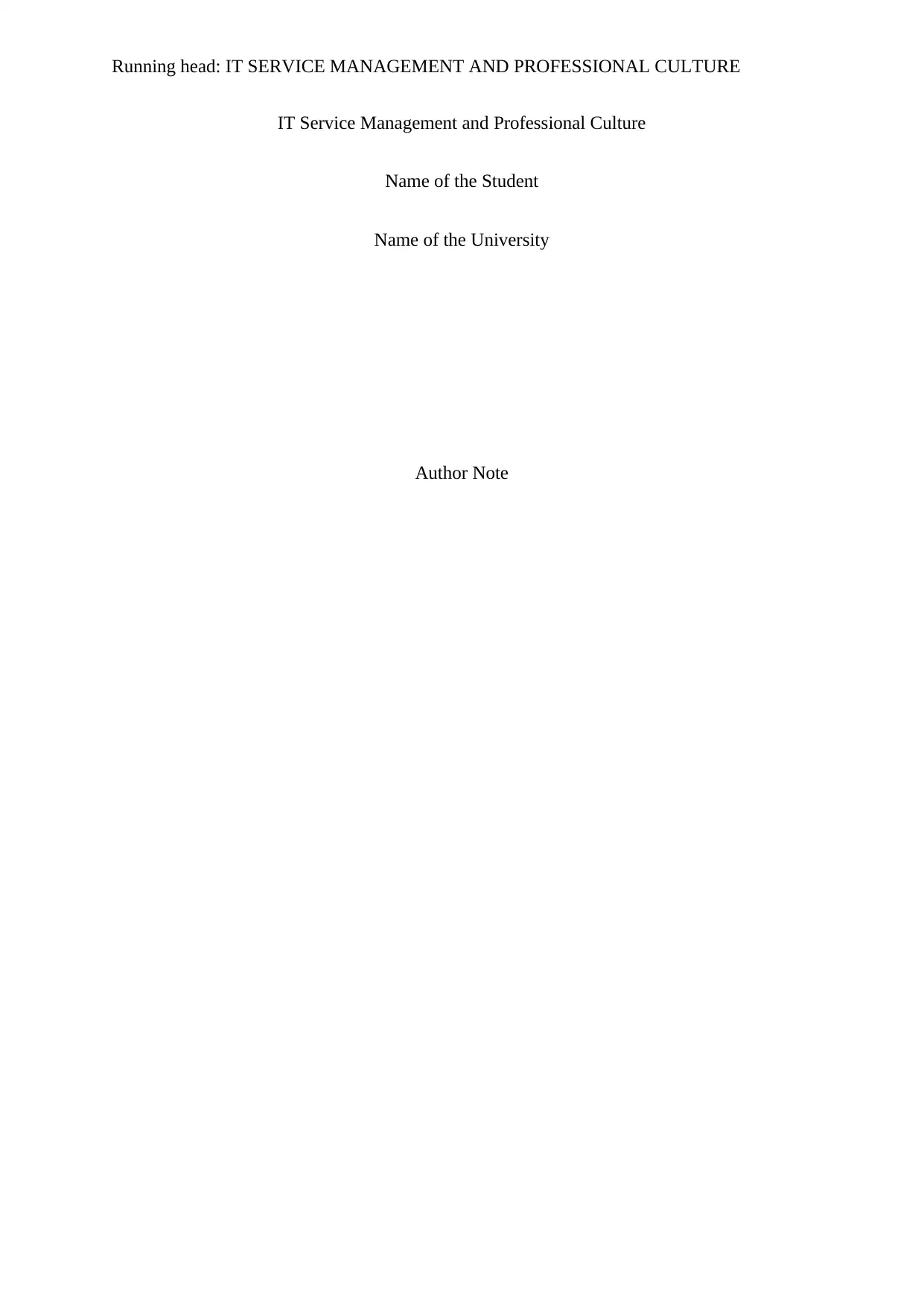
Running head: IT SERVICE MANAGEMENT AND PROFESSIONAL CULTURE
IT Service Management and Professional Culture
Name of the Student
Name of the University
Author Note
IT Service Management and Professional Culture
Name of the Student
Name of the University
Author Note
Paraphrase This Document
Need a fresh take? Get an instant paraphrase of this document with our AI Paraphraser
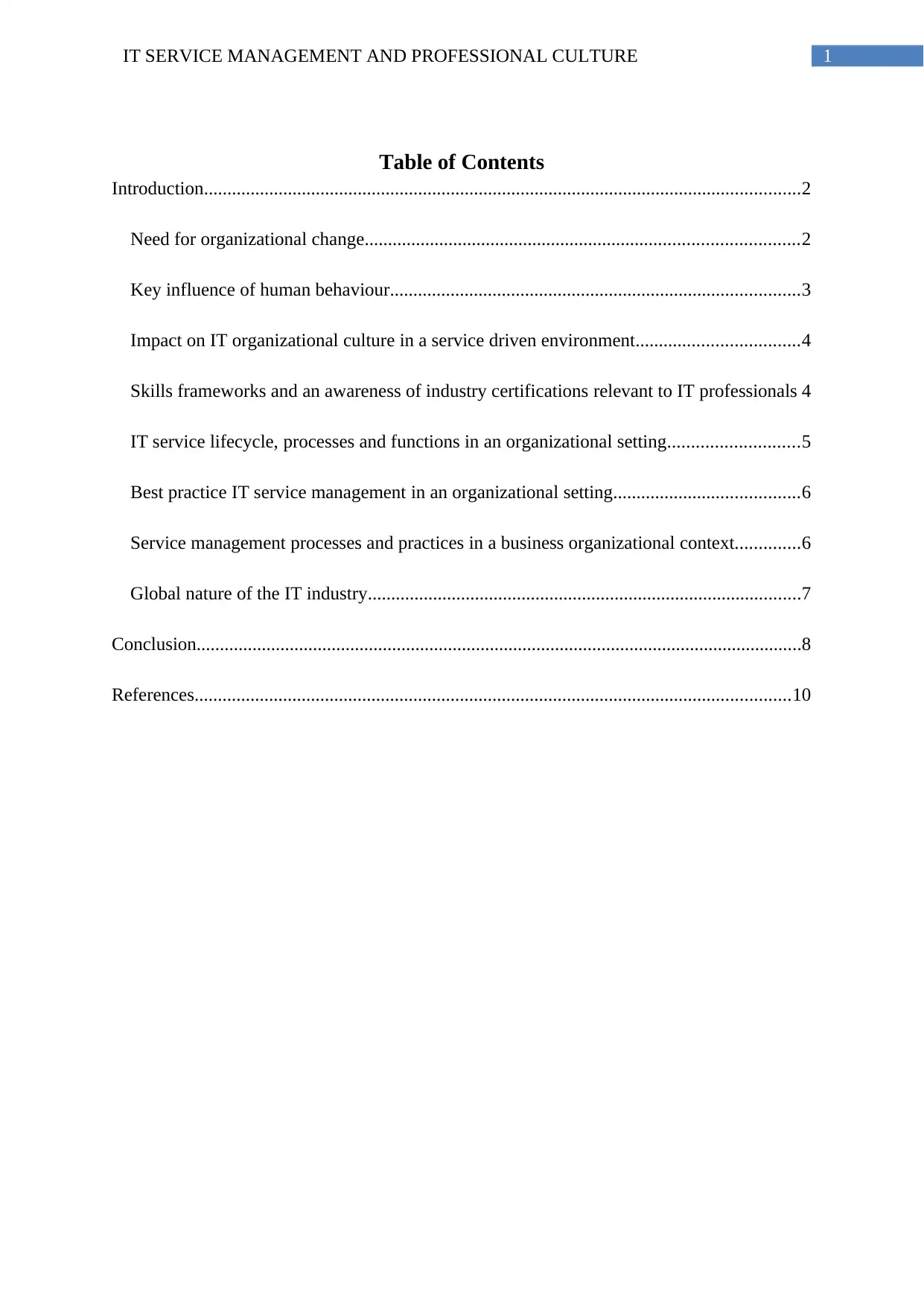
1IT SERVICE MANAGEMENT AND PROFESSIONAL CULTURE
Table of Contents
Introduction................................................................................................................................2
Need for organizational change.............................................................................................2
Key influence of human behaviour........................................................................................3
Impact on IT organizational culture in a service driven environment...................................4
Skills frameworks and an awareness of industry certifications relevant to IT professionals 4
IT service lifecycle, processes and functions in an organizational setting............................5
Best practice IT service management in an organizational setting........................................6
Service management processes and practices in a business organizational context..............6
Global nature of the IT industry.............................................................................................7
Conclusion..................................................................................................................................8
References................................................................................................................................10
Table of Contents
Introduction................................................................................................................................2
Need for organizational change.............................................................................................2
Key influence of human behaviour........................................................................................3
Impact on IT organizational culture in a service driven environment...................................4
Skills frameworks and an awareness of industry certifications relevant to IT professionals 4
IT service lifecycle, processes and functions in an organizational setting............................5
Best practice IT service management in an organizational setting........................................6
Service management processes and practices in a business organizational context..............6
Global nature of the IT industry.............................................................................................7
Conclusion..................................................................................................................................8
References................................................................................................................................10
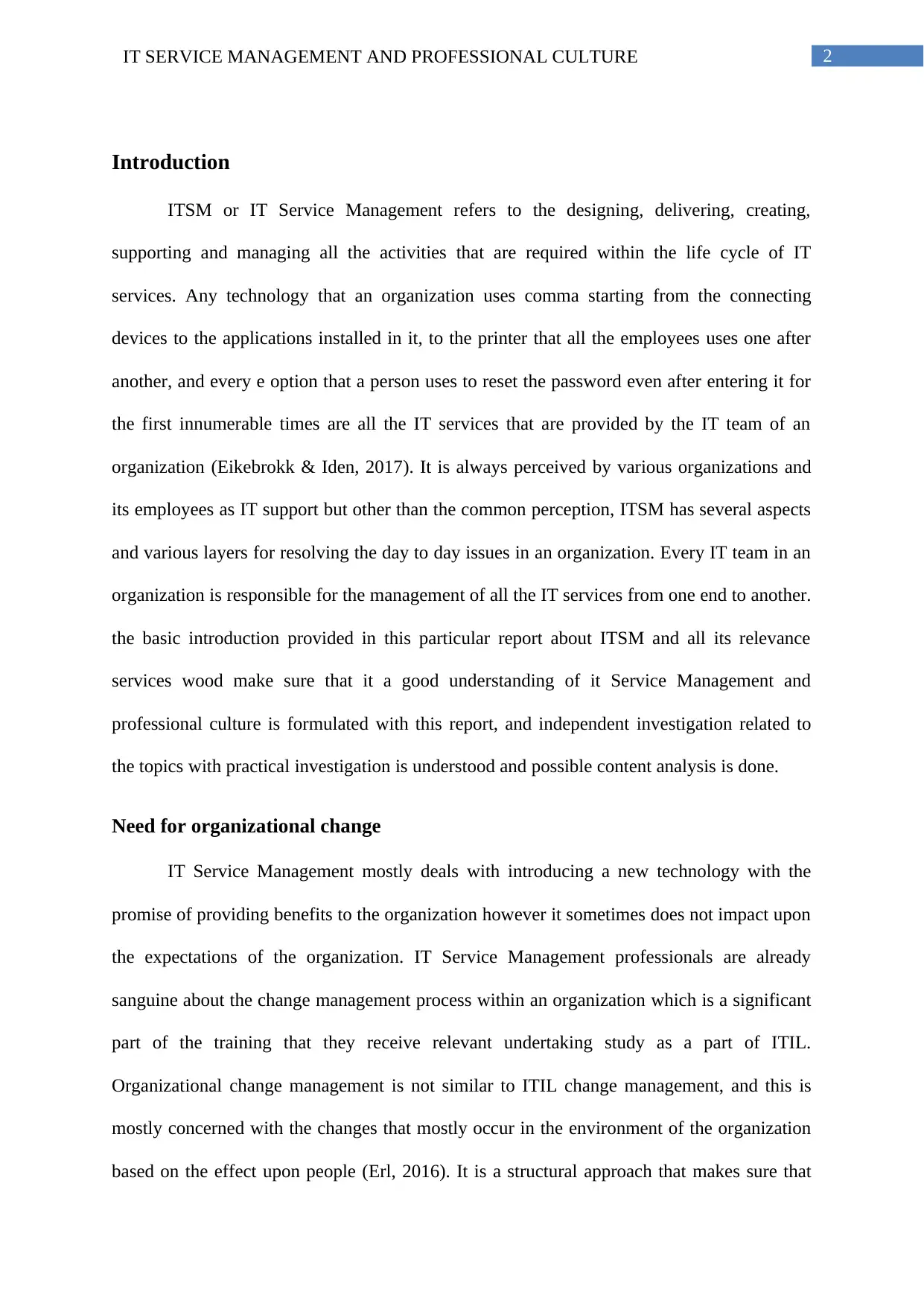
2IT SERVICE MANAGEMENT AND PROFESSIONAL CULTURE
Introduction
ITSM or IT Service Management refers to the designing, delivering, creating,
supporting and managing all the activities that are required within the life cycle of IT
services. Any technology that an organization uses comma starting from the connecting
devices to the applications installed in it, to the printer that all the employees uses one after
another, and every e option that a person uses to reset the password even after entering it for
the first innumerable times are all the IT services that are provided by the IT team of an
organization (Eikebrokk & Iden, 2017). It is always perceived by various organizations and
its employees as IT support but other than the common perception, ITSM has several aspects
and various layers for resolving the day to day issues in an organization. Every IT team in an
organization is responsible for the management of all the IT services from one end to another.
the basic introduction provided in this particular report about ITSM and all its relevance
services wood make sure that it a good understanding of it Service Management and
professional culture is formulated with this report, and independent investigation related to
the topics with practical investigation is understood and possible content analysis is done.
Need for organizational change
IT Service Management mostly deals with introducing a new technology with the
promise of providing benefits to the organization however it sometimes does not impact upon
the expectations of the organization. IT Service Management professionals are already
sanguine about the change management process within an organization which is a significant
part of the training that they receive relevant undertaking study as a part of ITIL.
Organizational change management is not similar to ITIL change management, and this is
mostly concerned with the changes that mostly occur in the environment of the organization
based on the effect upon people (Erl, 2016). It is a structural approach that makes sure that
Introduction
ITSM or IT Service Management refers to the designing, delivering, creating,
supporting and managing all the activities that are required within the life cycle of IT
services. Any technology that an organization uses comma starting from the connecting
devices to the applications installed in it, to the printer that all the employees uses one after
another, and every e option that a person uses to reset the password even after entering it for
the first innumerable times are all the IT services that are provided by the IT team of an
organization (Eikebrokk & Iden, 2017). It is always perceived by various organizations and
its employees as IT support but other than the common perception, ITSM has several aspects
and various layers for resolving the day to day issues in an organization. Every IT team in an
organization is responsible for the management of all the IT services from one end to another.
the basic introduction provided in this particular report about ITSM and all its relevance
services wood make sure that it a good understanding of it Service Management and
professional culture is formulated with this report, and independent investigation related to
the topics with practical investigation is understood and possible content analysis is done.
Need for organizational change
IT Service Management mostly deals with introducing a new technology with the
promise of providing benefits to the organization however it sometimes does not impact upon
the expectations of the organization. IT Service Management professionals are already
sanguine about the change management process within an organization which is a significant
part of the training that they receive relevant undertaking study as a part of ITIL.
Organizational change management is not similar to ITIL change management, and this is
mostly concerned with the changes that mostly occur in the environment of the organization
based on the effect upon people (Erl, 2016). It is a structural approach that makes sure that
⊘ This is a preview!⊘
Do you want full access?
Subscribe today to unlock all pages.

Trusted by 1+ million students worldwide
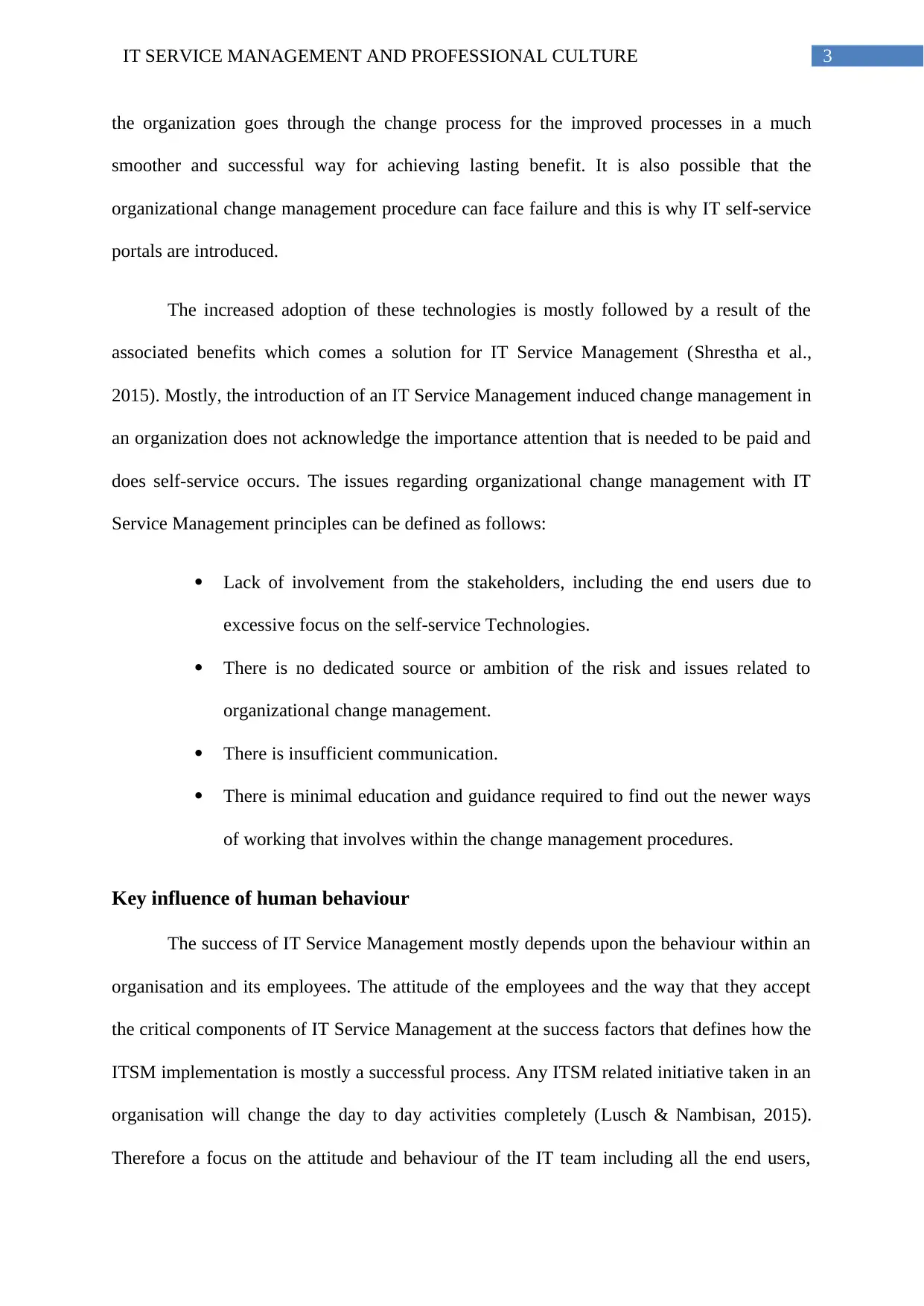
3IT SERVICE MANAGEMENT AND PROFESSIONAL CULTURE
the organization goes through the change process for the improved processes in a much
smoother and successful way for achieving lasting benefit. It is also possible that the
organizational change management procedure can face failure and this is why IT self-service
portals are introduced.
The increased adoption of these technologies is mostly followed by a result of the
associated benefits which comes a solution for IT Service Management (Shrestha et al.,
2015). Mostly, the introduction of an IT Service Management induced change management in
an organization does not acknowledge the importance attention that is needed to be paid and
does self-service occurs. The issues regarding organizational change management with IT
Service Management principles can be defined as follows:
Lack of involvement from the stakeholders, including the end users due to
excessive focus on the self-service Technologies.
There is no dedicated source or ambition of the risk and issues related to
organizational change management.
There is insufficient communication.
There is minimal education and guidance required to find out the newer ways
of working that involves within the change management procedures.
Key influence of human behaviour
The success of IT Service Management mostly depends upon the behaviour within an
organisation and its employees. The attitude of the employees and the way that they accept
the critical components of IT Service Management at the success factors that defines how the
ITSM implementation is mostly a successful process. Any ITSM related initiative taken in an
organisation will change the day to day activities completely (Lusch & Nambisan, 2015).
Therefore a focus on the attitude and behaviour of the IT team including all the end users,
the organization goes through the change process for the improved processes in a much
smoother and successful way for achieving lasting benefit. It is also possible that the
organizational change management procedure can face failure and this is why IT self-service
portals are introduced.
The increased adoption of these technologies is mostly followed by a result of the
associated benefits which comes a solution for IT Service Management (Shrestha et al.,
2015). Mostly, the introduction of an IT Service Management induced change management in
an organization does not acknowledge the importance attention that is needed to be paid and
does self-service occurs. The issues regarding organizational change management with IT
Service Management principles can be defined as follows:
Lack of involvement from the stakeholders, including the end users due to
excessive focus on the self-service Technologies.
There is no dedicated source or ambition of the risk and issues related to
organizational change management.
There is insufficient communication.
There is minimal education and guidance required to find out the newer ways
of working that involves within the change management procedures.
Key influence of human behaviour
The success of IT Service Management mostly depends upon the behaviour within an
organisation and its employees. The attitude of the employees and the way that they accept
the critical components of IT Service Management at the success factors that defines how the
ITSM implementation is mostly a successful process. Any ITSM related initiative taken in an
organisation will change the day to day activities completely (Lusch & Nambisan, 2015).
Therefore a focus on the attitude and behaviour of the IT team including all the end users,
Paraphrase This Document
Need a fresh take? Get an instant paraphrase of this document with our AI Paraphraser
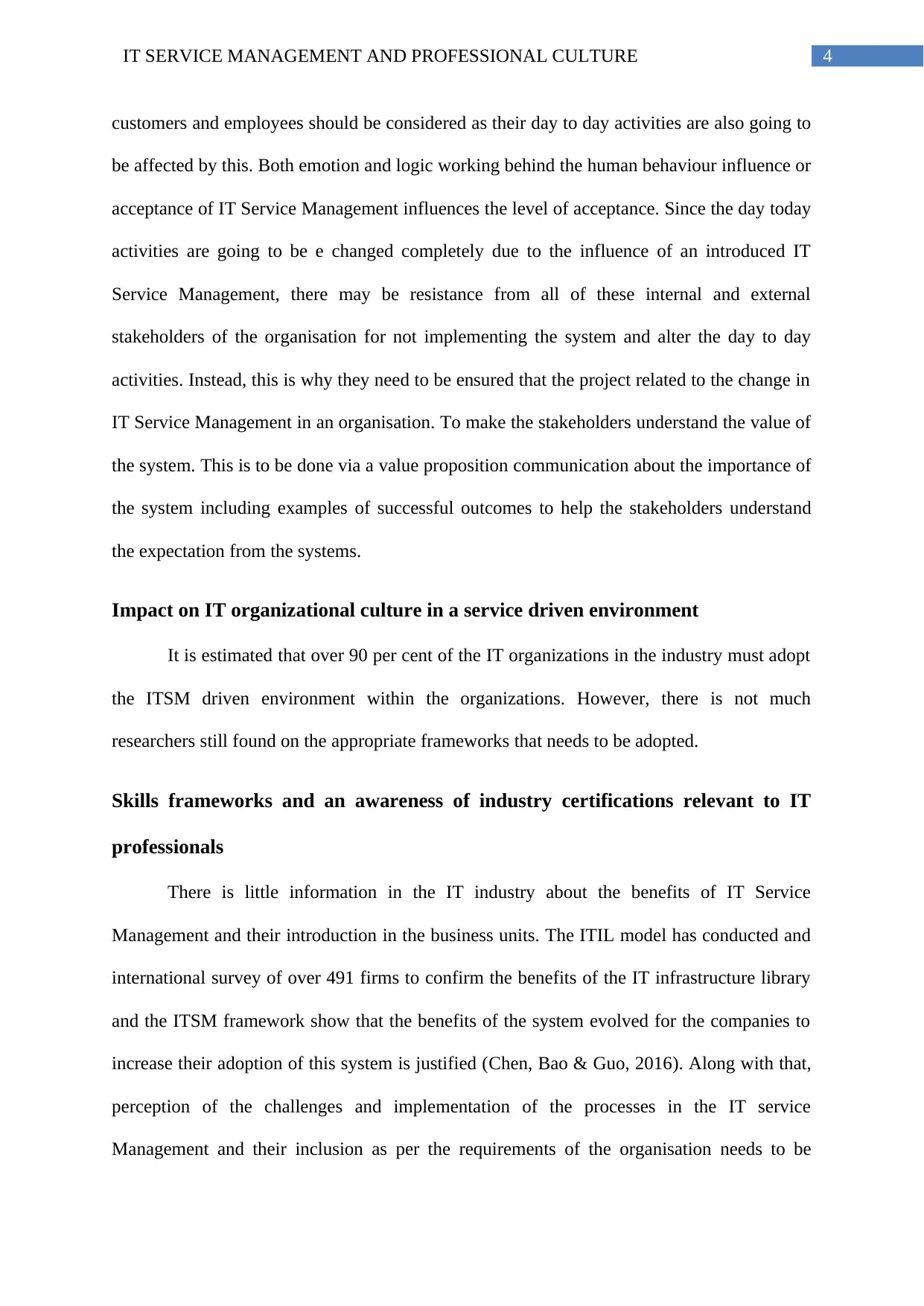
4IT SERVICE MANAGEMENT AND PROFESSIONAL CULTURE
customers and employees should be considered as their day to day activities are also going to
be affected by this. Both emotion and logic working behind the human behaviour influence or
acceptance of IT Service Management influences the level of acceptance. Since the day today
activities are going to be e changed completely due to the influence of an introduced IT
Service Management, there may be resistance from all of these internal and external
stakeholders of the organisation for not implementing the system and alter the day to day
activities. Instead, this is why they need to be ensured that the project related to the change in
IT Service Management in an organisation. To make the stakeholders understand the value of
the system. This is to be done via a value proposition communication about the importance of
the system including examples of successful outcomes to help the stakeholders understand
the expectation from the systems.
Impact on IT organizational culture in a service driven environment
It is estimated that over 90 per cent of the IT organizations in the industry must adopt
the ITSM driven environment within the organizations. However, there is not much
researchers still found on the appropriate frameworks that needs to be adopted.
Skills frameworks and an awareness of industry certifications relevant to IT
professionals
There is little information in the IT industry about the benefits of IT Service
Management and their introduction in the business units. The ITIL model has conducted and
international survey of over 491 firms to confirm the benefits of the IT infrastructure library
and the ITSM framework show that the benefits of the system evolved for the companies to
increase their adoption of this system is justified (Chen, Bao & Guo, 2016). Along with that,
perception of the challenges and implementation of the processes in the IT service
Management and their inclusion as per the requirements of the organisation needs to be
customers and employees should be considered as their day to day activities are also going to
be affected by this. Both emotion and logic working behind the human behaviour influence or
acceptance of IT Service Management influences the level of acceptance. Since the day today
activities are going to be e changed completely due to the influence of an introduced IT
Service Management, there may be resistance from all of these internal and external
stakeholders of the organisation for not implementing the system and alter the day to day
activities. Instead, this is why they need to be ensured that the project related to the change in
IT Service Management in an organisation. To make the stakeholders understand the value of
the system. This is to be done via a value proposition communication about the importance of
the system including examples of successful outcomes to help the stakeholders understand
the expectation from the systems.
Impact on IT organizational culture in a service driven environment
It is estimated that over 90 per cent of the IT organizations in the industry must adopt
the ITSM driven environment within the organizations. However, there is not much
researchers still found on the appropriate frameworks that needs to be adopted.
Skills frameworks and an awareness of industry certifications relevant to IT
professionals
There is little information in the IT industry about the benefits of IT Service
Management and their introduction in the business units. The ITIL model has conducted and
international survey of over 491 firms to confirm the benefits of the IT infrastructure library
and the ITSM framework show that the benefits of the system evolved for the companies to
increase their adoption of this system is justified (Chen, Bao & Guo, 2016). Along with that,
perception of the challenges and implementation of the processes in the IT service
Management and their inclusion as per the requirements of the organisation needs to be
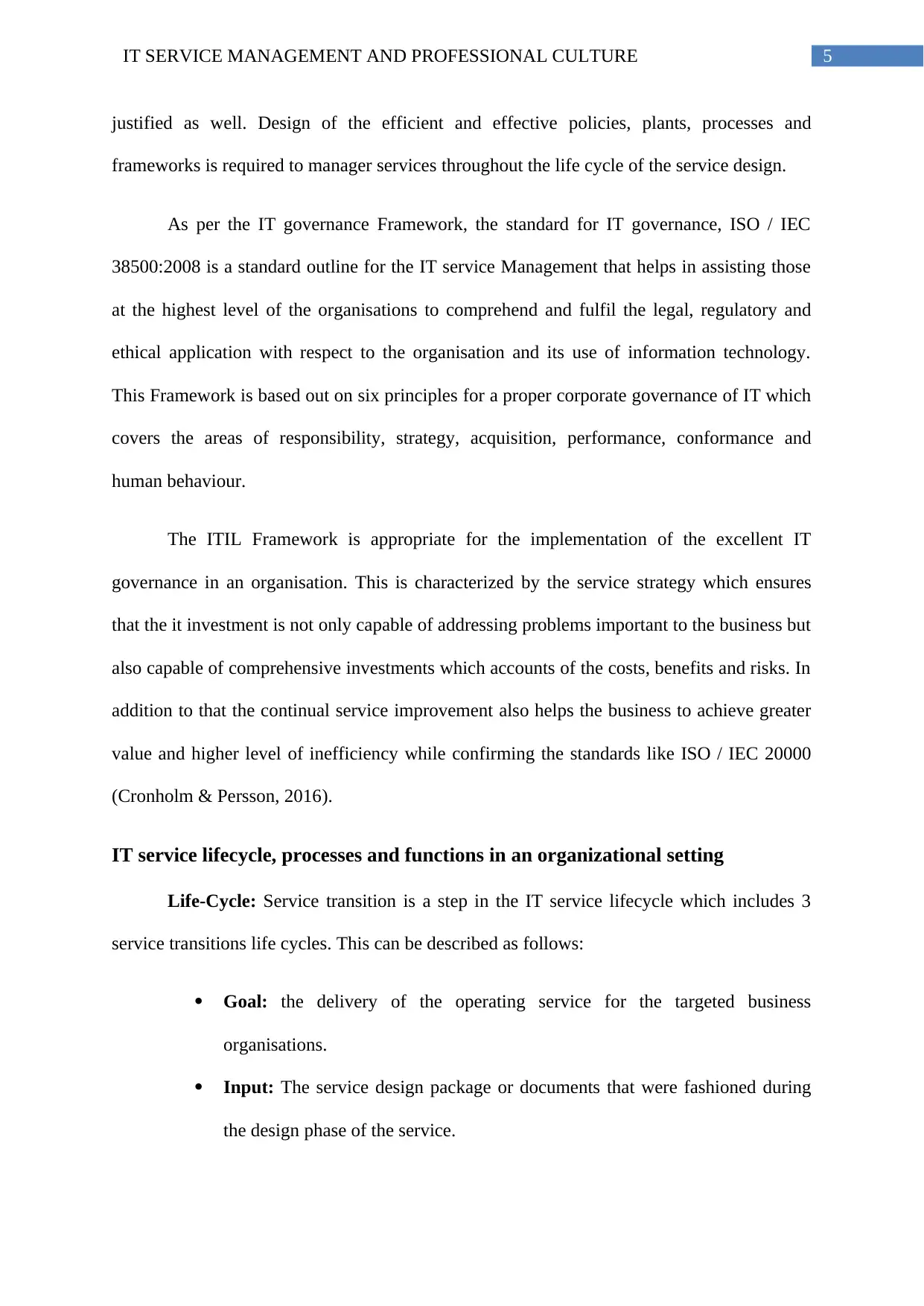
5IT SERVICE MANAGEMENT AND PROFESSIONAL CULTURE
justified as well. Design of the efficient and effective policies, plants, processes and
frameworks is required to manager services throughout the life cycle of the service design.
As per the IT governance Framework, the standard for IT governance, ISO / IEC
38500:2008 is a standard outline for the IT service Management that helps in assisting those
at the highest level of the organisations to comprehend and fulfil the legal, regulatory and
ethical application with respect to the organisation and its use of information technology.
This Framework is based out on six principles for a proper corporate governance of IT which
covers the areas of responsibility, strategy, acquisition, performance, conformance and
human behaviour.
The ITIL Framework is appropriate for the implementation of the excellent IT
governance in an organisation. This is characterized by the service strategy which ensures
that the it investment is not only capable of addressing problems important to the business but
also capable of comprehensive investments which accounts of the costs, benefits and risks. In
addition to that the continual service improvement also helps the business to achieve greater
value and higher level of inefficiency while confirming the standards like ISO / IEC 20000
(Cronholm & Persson, 2016).
IT service lifecycle, processes and functions in an organizational setting
Life-Cycle: Service transition is a step in the IT service lifecycle which includes 3
service transitions life cycles. This can be described as follows:
Goal: the delivery of the operating service for the targeted business
organisations.
Input: The service design package or documents that were fashioned during
the design phase of the service.
justified as well. Design of the efficient and effective policies, plants, processes and
frameworks is required to manager services throughout the life cycle of the service design.
As per the IT governance Framework, the standard for IT governance, ISO / IEC
38500:2008 is a standard outline for the IT service Management that helps in assisting those
at the highest level of the organisations to comprehend and fulfil the legal, regulatory and
ethical application with respect to the organisation and its use of information technology.
This Framework is based out on six principles for a proper corporate governance of IT which
covers the areas of responsibility, strategy, acquisition, performance, conformance and
human behaviour.
The ITIL Framework is appropriate for the implementation of the excellent IT
governance in an organisation. This is characterized by the service strategy which ensures
that the it investment is not only capable of addressing problems important to the business but
also capable of comprehensive investments which accounts of the costs, benefits and risks. In
addition to that the continual service improvement also helps the business to achieve greater
value and higher level of inefficiency while confirming the standards like ISO / IEC 20000
(Cronholm & Persson, 2016).
IT service lifecycle, processes and functions in an organizational setting
Life-Cycle: Service transition is a step in the IT service lifecycle which includes 3
service transitions life cycles. This can be described as follows:
Goal: the delivery of the operating service for the targeted business
organisations.
Input: The service design package or documents that were fashioned during
the design phase of the service.
⊘ This is a preview!⊘
Do you want full access?
Subscribe today to unlock all pages.

Trusted by 1+ million students worldwide
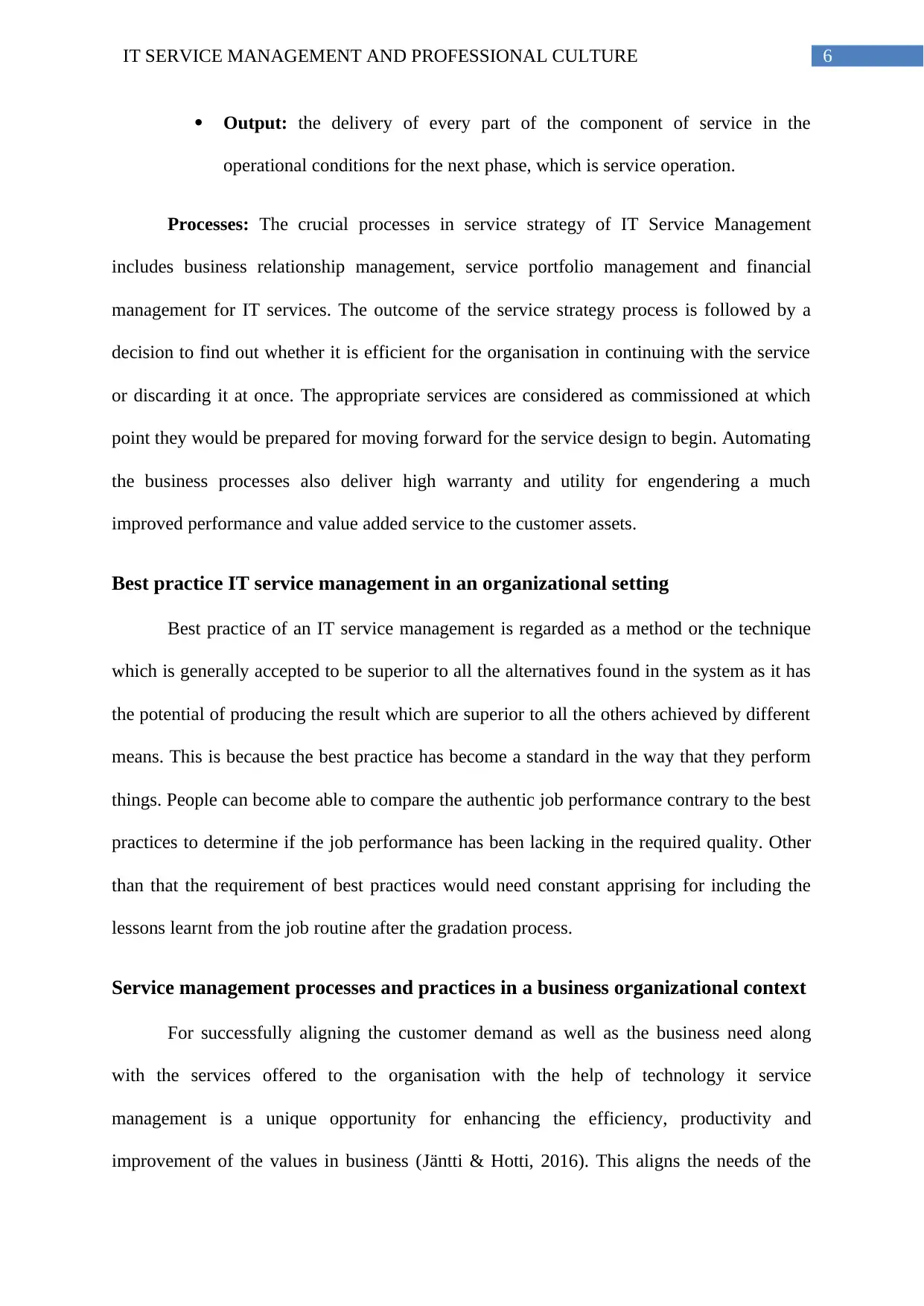
6IT SERVICE MANAGEMENT AND PROFESSIONAL CULTURE
Output: the delivery of every part of the component of service in the
operational conditions for the next phase, which is service operation.
Processes: The crucial processes in service strategy of IT Service Management
includes business relationship management, service portfolio management and financial
management for IT services. The outcome of the service strategy process is followed by a
decision to find out whether it is efficient for the organisation in continuing with the service
or discarding it at once. The appropriate services are considered as commissioned at which
point they would be prepared for moving forward for the service design to begin. Automating
the business processes also deliver high warranty and utility for engendering a much
improved performance and value added service to the customer assets.
Best practice IT service management in an organizational setting
Best practice of an IT service management is regarded as a method or the technique
which is generally accepted to be superior to all the alternatives found in the system as it has
the potential of producing the result which are superior to all the others achieved by different
means. This is because the best practice has become a standard in the way that they perform
things. People can become able to compare the authentic job performance contrary to the best
practices to determine if the job performance has been lacking in the required quality. Other
than that the requirement of best practices would need constant apprising for including the
lessons learnt from the job routine after the gradation process.
Service management processes and practices in a business organizational context
For successfully aligning the customer demand as well as the business need along
with the services offered to the organisation with the help of technology it service
management is a unique opportunity for enhancing the efficiency, productivity and
improvement of the values in business (Jäntti & Hotti, 2016). This aligns the needs of the
Output: the delivery of every part of the component of service in the
operational conditions for the next phase, which is service operation.
Processes: The crucial processes in service strategy of IT Service Management
includes business relationship management, service portfolio management and financial
management for IT services. The outcome of the service strategy process is followed by a
decision to find out whether it is efficient for the organisation in continuing with the service
or discarding it at once. The appropriate services are considered as commissioned at which
point they would be prepared for moving forward for the service design to begin. Automating
the business processes also deliver high warranty and utility for engendering a much
improved performance and value added service to the customer assets.
Best practice IT service management in an organizational setting
Best practice of an IT service management is regarded as a method or the technique
which is generally accepted to be superior to all the alternatives found in the system as it has
the potential of producing the result which are superior to all the others achieved by different
means. This is because the best practice has become a standard in the way that they perform
things. People can become able to compare the authentic job performance contrary to the best
practices to determine if the job performance has been lacking in the required quality. Other
than that the requirement of best practices would need constant apprising for including the
lessons learnt from the job routine after the gradation process.
Service management processes and practices in a business organizational context
For successfully aligning the customer demand as well as the business need along
with the services offered to the organisation with the help of technology it service
management is a unique opportunity for enhancing the efficiency, productivity and
improvement of the values in business (Jäntti & Hotti, 2016). This aligns the needs of the
Paraphrase This Document
Need a fresh take? Get an instant paraphrase of this document with our AI Paraphraser
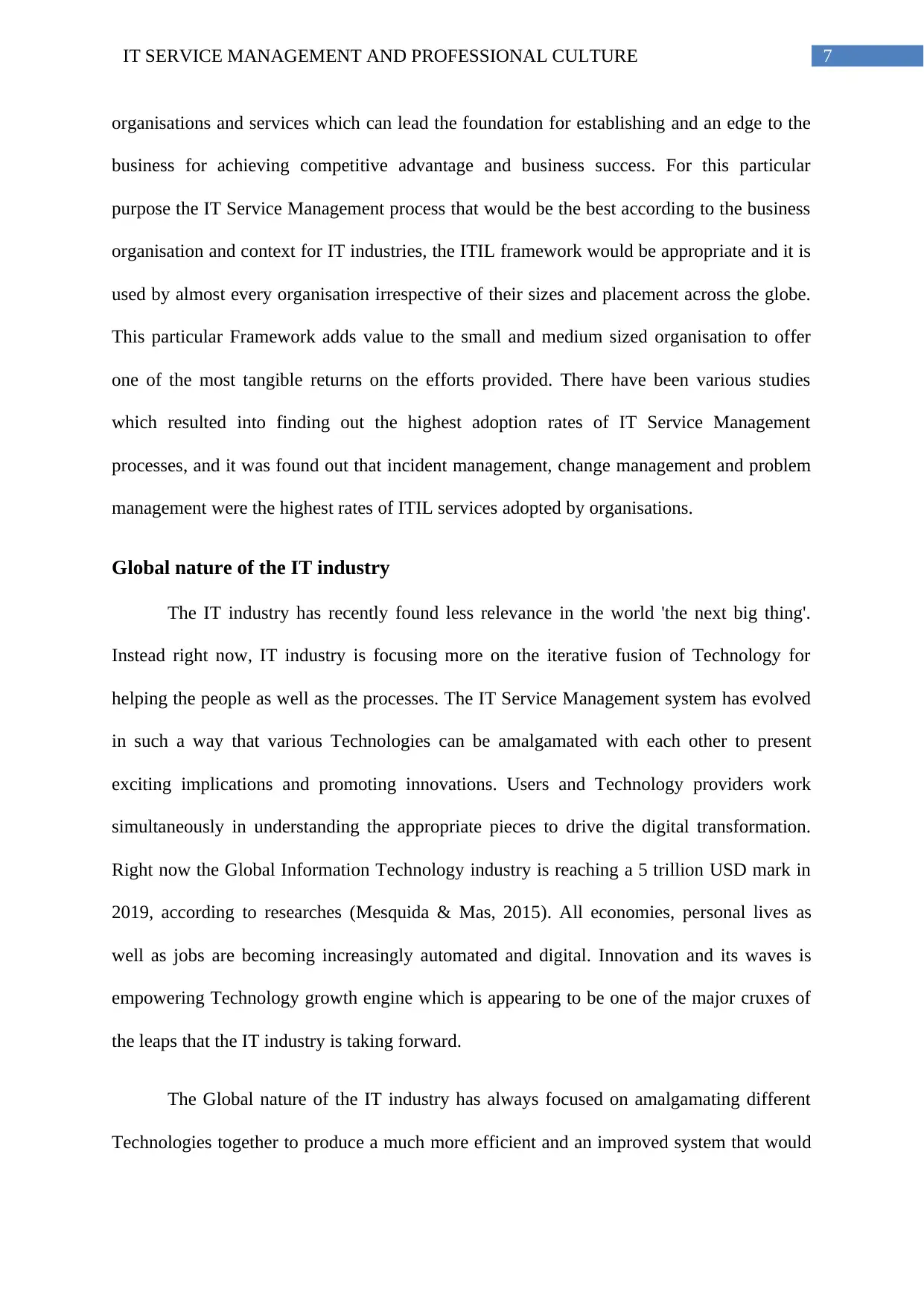
7IT SERVICE MANAGEMENT AND PROFESSIONAL CULTURE
organisations and services which can lead the foundation for establishing and an edge to the
business for achieving competitive advantage and business success. For this particular
purpose the IT Service Management process that would be the best according to the business
organisation and context for IT industries, the ITIL framework would be appropriate and it is
used by almost every organisation irrespective of their sizes and placement across the globe.
This particular Framework adds value to the small and medium sized organisation to offer
one of the most tangible returns on the efforts provided. There have been various studies
which resulted into finding out the highest adoption rates of IT Service Management
processes, and it was found out that incident management, change management and problem
management were the highest rates of ITIL services adopted by organisations.
Global nature of the IT industry
The IT industry has recently found less relevance in the world 'the next big thing'.
Instead right now, IT industry is focusing more on the iterative fusion of Technology for
helping the people as well as the processes. The IT Service Management system has evolved
in such a way that various Technologies can be amalgamated with each other to present
exciting implications and promoting innovations. Users and Technology providers work
simultaneously in understanding the appropriate pieces to drive the digital transformation.
Right now the Global Information Technology industry is reaching a 5 trillion USD mark in
2019, according to researches (Mesquida & Mas, 2015). All economies, personal lives as
well as jobs are becoming increasingly automated and digital. Innovation and its waves is
empowering Technology growth engine which is appearing to be one of the major cruxes of
the leaps that the IT industry is taking forward.
The Global nature of the IT industry has always focused on amalgamating different
Technologies together to produce a much more efficient and an improved system that would
organisations and services which can lead the foundation for establishing and an edge to the
business for achieving competitive advantage and business success. For this particular
purpose the IT Service Management process that would be the best according to the business
organisation and context for IT industries, the ITIL framework would be appropriate and it is
used by almost every organisation irrespective of their sizes and placement across the globe.
This particular Framework adds value to the small and medium sized organisation to offer
one of the most tangible returns on the efforts provided. There have been various studies
which resulted into finding out the highest adoption rates of IT Service Management
processes, and it was found out that incident management, change management and problem
management were the highest rates of ITIL services adopted by organisations.
Global nature of the IT industry
The IT industry has recently found less relevance in the world 'the next big thing'.
Instead right now, IT industry is focusing more on the iterative fusion of Technology for
helping the people as well as the processes. The IT Service Management system has evolved
in such a way that various Technologies can be amalgamated with each other to present
exciting implications and promoting innovations. Users and Technology providers work
simultaneously in understanding the appropriate pieces to drive the digital transformation.
Right now the Global Information Technology industry is reaching a 5 trillion USD mark in
2019, according to researches (Mesquida & Mas, 2015). All economies, personal lives as
well as jobs are becoming increasingly automated and digital. Innovation and its waves is
empowering Technology growth engine which is appearing to be one of the major cruxes of
the leaps that the IT industry is taking forward.
The Global nature of the IT industry has always focused on amalgamating different
Technologies together to produce a much more efficient and an improved system that would
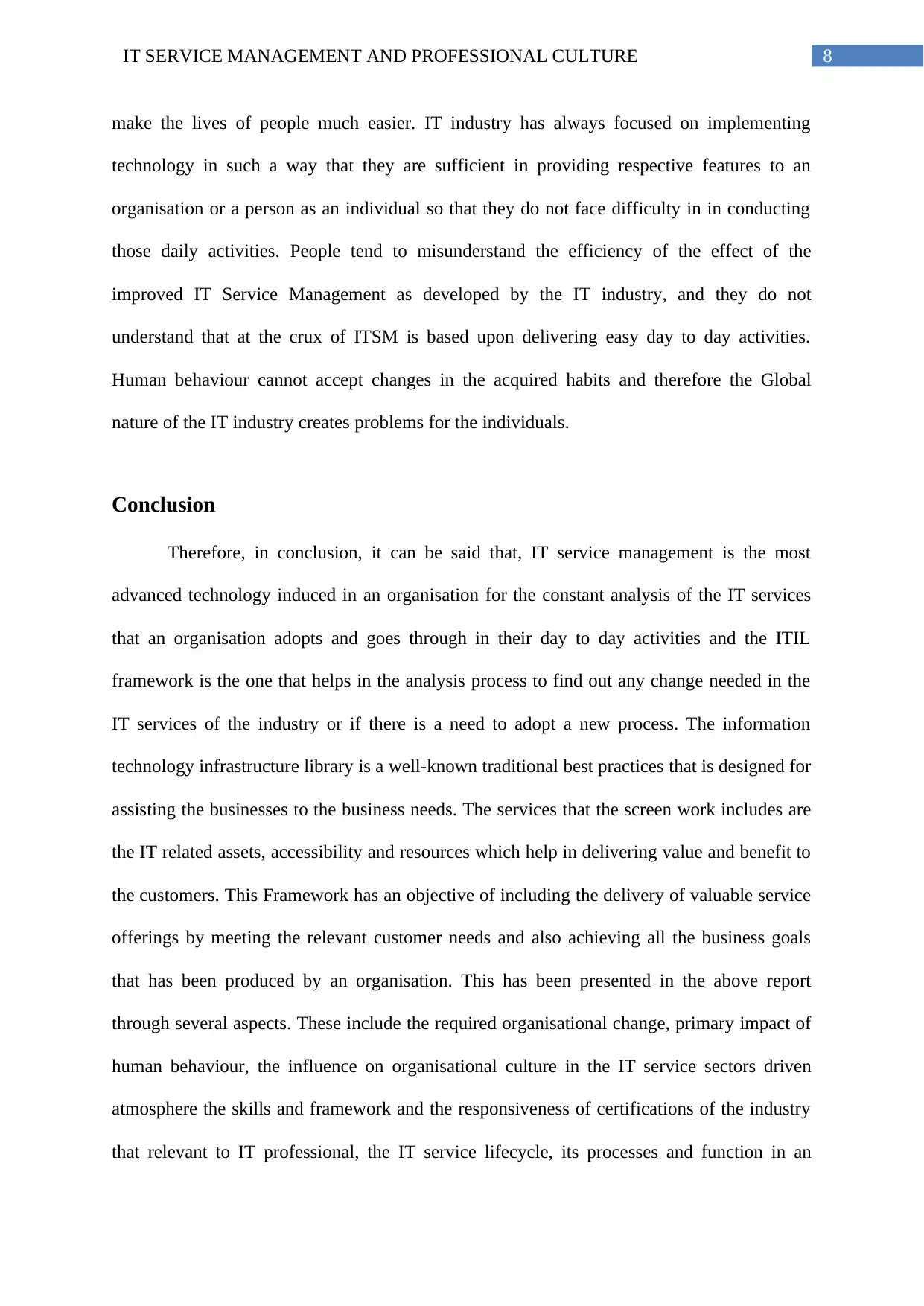
8IT SERVICE MANAGEMENT AND PROFESSIONAL CULTURE
make the lives of people much easier. IT industry has always focused on implementing
technology in such a way that they are sufficient in providing respective features to an
organisation or a person as an individual so that they do not face difficulty in in conducting
those daily activities. People tend to misunderstand the efficiency of the effect of the
improved IT Service Management as developed by the IT industry, and they do not
understand that at the crux of ITSM is based upon delivering easy day to day activities.
Human behaviour cannot accept changes in the acquired habits and therefore the Global
nature of the IT industry creates problems for the individuals.
Conclusion
Therefore, in conclusion, it can be said that, IT service management is the most
advanced technology induced in an organisation for the constant analysis of the IT services
that an organisation adopts and goes through in their day to day activities and the ITIL
framework is the one that helps in the analysis process to find out any change needed in the
IT services of the industry or if there is a need to adopt a new process. The information
technology infrastructure library is a well-known traditional best practices that is designed for
assisting the businesses to the business needs. The services that the screen work includes are
the IT related assets, accessibility and resources which help in delivering value and benefit to
the customers. This Framework has an objective of including the delivery of valuable service
offerings by meeting the relevant customer needs and also achieving all the business goals
that has been produced by an organisation. This has been presented in the above report
through several aspects. These include the required organisational change, primary impact of
human behaviour, the influence on organisational culture in the IT service sectors driven
atmosphere the skills and framework and the responsiveness of certifications of the industry
that relevant to IT professional, the IT service lifecycle, its processes and function in an
make the lives of people much easier. IT industry has always focused on implementing
technology in such a way that they are sufficient in providing respective features to an
organisation or a person as an individual so that they do not face difficulty in in conducting
those daily activities. People tend to misunderstand the efficiency of the effect of the
improved IT Service Management as developed by the IT industry, and they do not
understand that at the crux of ITSM is based upon delivering easy day to day activities.
Human behaviour cannot accept changes in the acquired habits and therefore the Global
nature of the IT industry creates problems for the individuals.
Conclusion
Therefore, in conclusion, it can be said that, IT service management is the most
advanced technology induced in an organisation for the constant analysis of the IT services
that an organisation adopts and goes through in their day to day activities and the ITIL
framework is the one that helps in the analysis process to find out any change needed in the
IT services of the industry or if there is a need to adopt a new process. The information
technology infrastructure library is a well-known traditional best practices that is designed for
assisting the businesses to the business needs. The services that the screen work includes are
the IT related assets, accessibility and resources which help in delivering value and benefit to
the customers. This Framework has an objective of including the delivery of valuable service
offerings by meeting the relevant customer needs and also achieving all the business goals
that has been produced by an organisation. This has been presented in the above report
through several aspects. These include the required organisational change, primary impact of
human behaviour, the influence on organisational culture in the IT service sectors driven
atmosphere the skills and framework and the responsiveness of certifications of the industry
that relevant to IT professional, the IT service lifecycle, its processes and function in an
⊘ This is a preview!⊘
Do you want full access?
Subscribe today to unlock all pages.

Trusted by 1+ million students worldwide
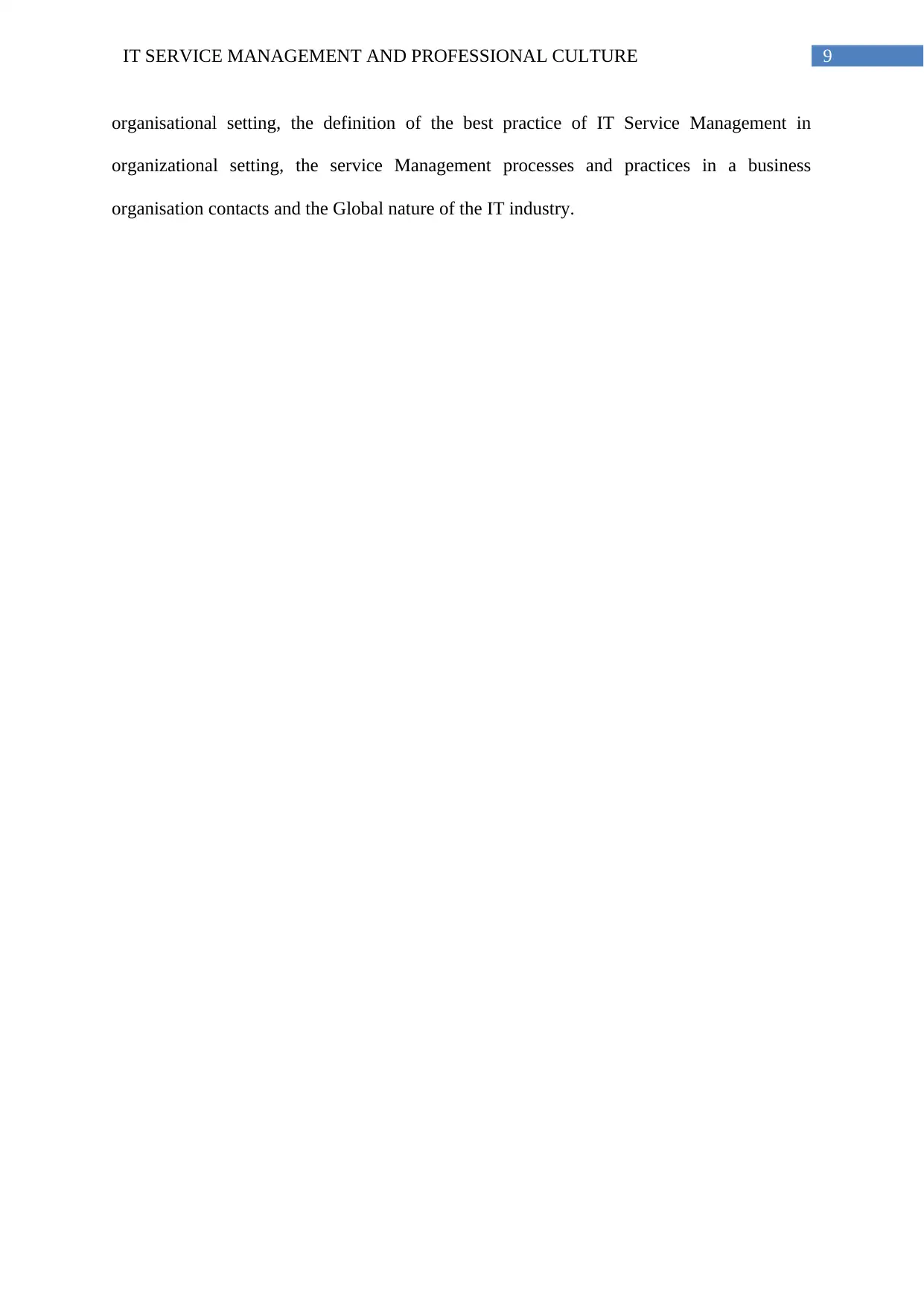
9IT SERVICE MANAGEMENT AND PROFESSIONAL CULTURE
organisational setting, the definition of the best practice of IT Service Management in
organizational setting, the service Management processes and practices in a business
organisation contacts and the Global nature of the IT industry.
organisational setting, the definition of the best practice of IT Service Management in
organizational setting, the service Management processes and practices in a business
organisation contacts and the Global nature of the IT industry.
Paraphrase This Document
Need a fresh take? Get an instant paraphrase of this document with our AI Paraphraser
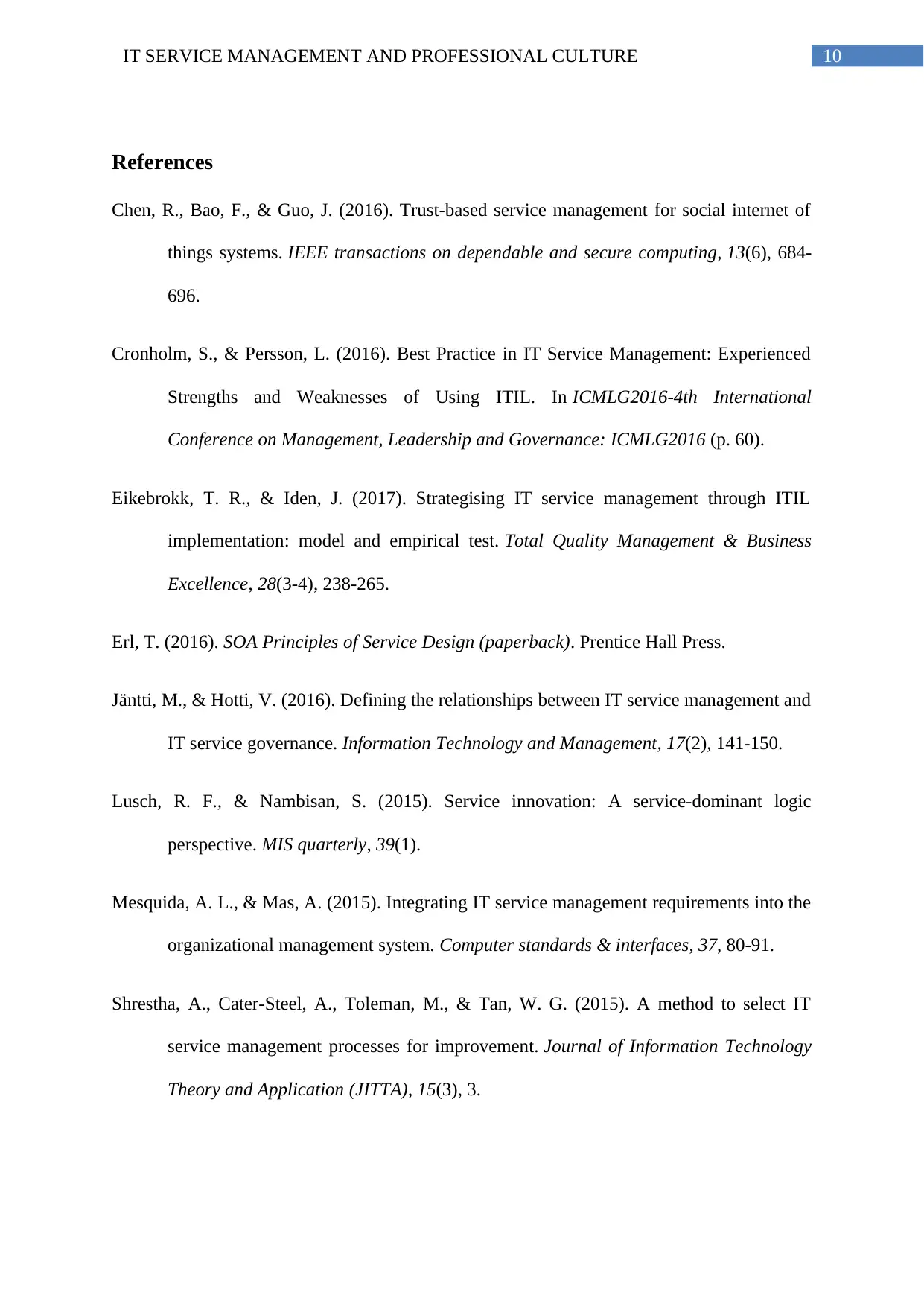
10IT SERVICE MANAGEMENT AND PROFESSIONAL CULTURE
References
Chen, R., Bao, F., & Guo, J. (2016). Trust-based service management for social internet of
things systems. IEEE transactions on dependable and secure computing, 13(6), 684-
696.
Cronholm, S., & Persson, L. (2016). Best Practice in IT Service Management: Experienced
Strengths and Weaknesses of Using ITIL. In ICMLG2016-4th International
Conference on Management, Leadership and Governance: ICMLG2016 (p. 60).
Eikebrokk, T. R., & Iden, J. (2017). Strategising IT service management through ITIL
implementation: model and empirical test. Total Quality Management & Business
Excellence, 28(3-4), 238-265.
Erl, T. (2016). SOA Principles of Service Design (paperback). Prentice Hall Press.
Jäntti, M., & Hotti, V. (2016). Defining the relationships between IT service management and
IT service governance. Information Technology and Management, 17(2), 141-150.
Lusch, R. F., & Nambisan, S. (2015). Service innovation: A service-dominant logic
perspective. MIS quarterly, 39(1).
Mesquida, A. L., & Mas, A. (2015). Integrating IT service management requirements into the
organizational management system. Computer standards & interfaces, 37, 80-91.
Shrestha, A., Cater-Steel, A., Toleman, M., & Tan, W. G. (2015). A method to select IT
service management processes for improvement. Journal of Information Technology
Theory and Application (JITTA), 15(3), 3.
References
Chen, R., Bao, F., & Guo, J. (2016). Trust-based service management for social internet of
things systems. IEEE transactions on dependable and secure computing, 13(6), 684-
696.
Cronholm, S., & Persson, L. (2016). Best Practice in IT Service Management: Experienced
Strengths and Weaknesses of Using ITIL. In ICMLG2016-4th International
Conference on Management, Leadership and Governance: ICMLG2016 (p. 60).
Eikebrokk, T. R., & Iden, J. (2017). Strategising IT service management through ITIL
implementation: model and empirical test. Total Quality Management & Business
Excellence, 28(3-4), 238-265.
Erl, T. (2016). SOA Principles of Service Design (paperback). Prentice Hall Press.
Jäntti, M., & Hotti, V. (2016). Defining the relationships between IT service management and
IT service governance. Information Technology and Management, 17(2), 141-150.
Lusch, R. F., & Nambisan, S. (2015). Service innovation: A service-dominant logic
perspective. MIS quarterly, 39(1).
Mesquida, A. L., & Mas, A. (2015). Integrating IT service management requirements into the
organizational management system. Computer standards & interfaces, 37, 80-91.
Shrestha, A., Cater-Steel, A., Toleman, M., & Tan, W. G. (2015). A method to select IT
service management processes for improvement. Journal of Information Technology
Theory and Application (JITTA), 15(3), 3.
1 out of 11
Related Documents
Your All-in-One AI-Powered Toolkit for Academic Success.
+13062052269
info@desklib.com
Available 24*7 on WhatsApp / Email
![[object Object]](/_next/static/media/star-bottom.7253800d.svg)
Unlock your academic potential
Copyright © 2020–2025 A2Z Services. All Rights Reserved. Developed and managed by ZUCOL.



